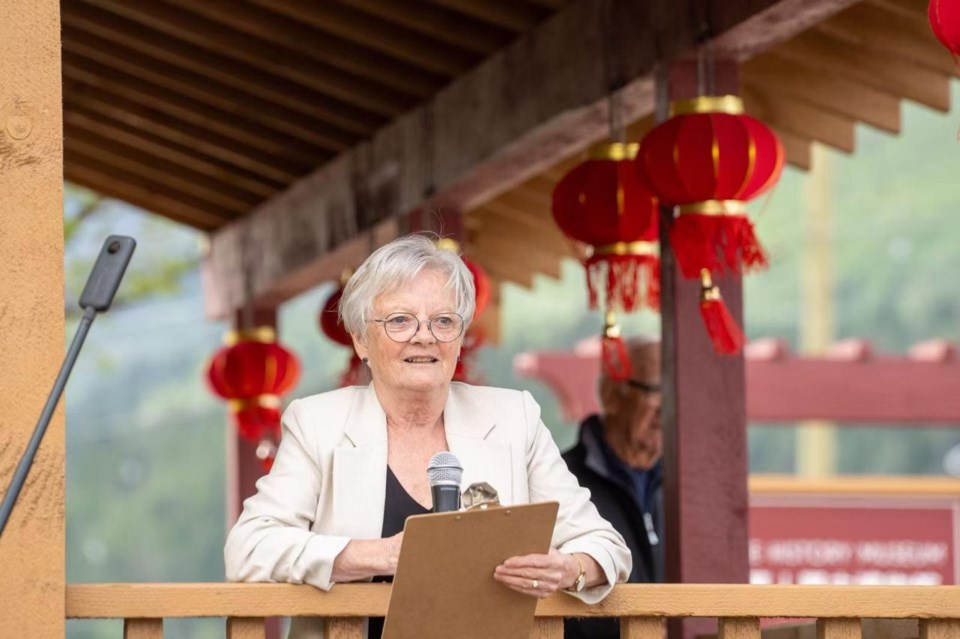LYTTON — Lorna Fandrich recalled walking into the burned out site of the Lytton Chinese History Museum in October 2021, about four months after it and most of the village were destroyed by a wildfire that claimed two lives.
Clad in protective gear, she sifted through foot-deep ashes in the hope of recovering some of the artifacts that documented the Chinese community's presence in the B.C. Interior, stretching back to the 19th century.
"Those were sad days," said Fandrich, who originally built the museum in 2017 after discovering that a plot of land her family owned had once been the site of the Chinese community's joss house, or temple.
"After the fire was a major decision on whether I'd rebuild or not. I was still hoping to tell this Chinese story, but the building was insured for far less than the cost of construction."
Now, the replacement museum has reopened, rising like a "phoenix coming from the ashes," said arts and tourism minister Spencer Chandra Herbert at a ceremony on Saturday.
From the outside, the new museum looks almost exactly like its predecessor. But just 40 of the 1,600 artifacts that were in the original survived in good condition.
So began the painstaking task of rebuilding the collection that shows the history of the Chinese community in the area, working as gold miners and railway builders.
Fandrich, who has operated a rafting business in Lytton with husband Bernie for more than 50 years, said more than 90 per cent of the items now on display were donated since the fire.
In the basement are a further 200 of the original exhibits that were recovered with the help of the British Columbia Heritage Emergency Recovery Network but were too badly damaged to display.
Fandrich said she was also overwhelmed by support and donations from individuals and organizations who gave a total of $150,000 to rebuild the museum.
Artifact donations include pottery and statues, while photographs also depict the history of the Chinese community in the area. There is also a section devoted to the Lytton fire that includes scorched artifacts.
Donations continued on Saturday -- guests presented Fandrich with an ivory mah-jong set and table.
"I was amazed how many people just kept contacting me ... I feel like it's appreciated and it's worthwhile, what I am doing here," said Fandrich.
But many items lost in the fire were irreplaceable.
Among them, a baby headband donated by the Chong family, who first arrived in Lytton 140 years ago.
"Peter Chong gave it me to me when he was 92, so that means his mom kept it all those years, and then he kept it, and then he gave it to me, and then, of course, it burned. So I felt particularly bad about those personal ones," said Fandrich.
Now, the late resident's felt hat is on display instead.
Peter's brother, Ron Chong, 89, said his family shared close ties with Fandrich's for years and donated many artifacts to the museum.
Their grandfather was 18 when he arrived in Lytton in 1885. The family operated a general store, which Ron Chong said had a "special relationship" with the Indigenous communities that they served.
Chong and his wife moved to Burnaby after the fire. But he applauded Fandrich's decision to stay.
"I have great admiration for her strength and determination to rebuild this beautiful building after such a heart-wrenching loss," he said.
Fandrich said her family had suffered losses in the 2021 fire, which burned down her sons' houses and destroyed her daughter's coffee shop, as well as about $1.5 million in rafting equipment.
In February, the federal government promised more than $25 million to help build a new "community hub" in the village, part of $77 million in support that was promised in 2022.
Lytton Mayor Denise O’Connor said it was still painful to talk about the fire.
"I guess we were all in a place of grief, of trauma, a lot being lost, we lost not only our homes, but our town, and not knowing what the future was going to bring," said O’Connor.
"But we're past that, now we're rebuilding. We like to not call it recovery anymore. We like to say we're in the rebuilding phase -- even though we are still recovering."
Fandrich said she was optimistic about the village, where 90 per cent of buildings were destroyed by the fire.
"There'll be a whole new set of people coming in to make it vibrant. We need young people to come, and I think it has a future," said Fandrich.
This report by The Canadian Press was first published May. 5, 2025.
Nono Shen, The Canadian Press




